The bench press is one of the most important upper-body exercises in your movement toolkit. Not only is it crucial for upper-body muscular development, but it's an exceptional strength builder. Many people think the bench press is just a chest exercise, but I'm here to tell you that your triceps, shoulders, back, and even your glutes are involved. It's a complex movement that can be disastrous if you get it wrong.
If you've been doing the bench press without being too concerned about how you're doing it, it might be time for you to take a step back and focus on improving your technique. Seven years ago, I tore my right pec while bench pressing incorrectly. I'll tell you right now, it sucked.
Since then, I've spent a lot of years learning how to incorporate the correct muscle groups and focus on the proper execution of the movement itself. After learning how to improve my bench mechanics, not only did the movement become safer, but my numbers got a lot better.
So, if you're ready to get bigger and stronger, watch the video. In it, I detail what I've learned from technique experts like Ben Esgro, Mike Zourdos, and USA Powerlifting coach Matt Gary so you, too, can bench like the pros.
How to bench press
Set Your Feet
Although your foot placement isn't as crucial on the bench as it is for the deadlift or squat, it's still important. Your feet are the start of a strong base and are where you'll draw your power from.
Try to keep your feet back toward your butt as far as you can while still keeping them flat on the ground. Depending on your height and body type, this is going to look a little different for everyone. The point, though, is to plant your feet firmly so you can generate power from the ground through your entire body.
Position Yourself Under the Bar
Like your foot placement, your back position is going to look unique to you based on your build and mechanics. Essentially, though, you should set up far enough under the bar that it's easy to unrack, but not so far under it that you hit the pegs on the way up. Squeeze your shoulder blades together to stay tight and protect your shoulders. Imagine trying to crush a grape between your shoulder blades, and push your upper back into the bench.
Arch Your Back
This is a little bit of a controversial topic, especially among bodybuilders. Many bodybuilders think that arching your back is just a powerlifting move, but arching your lower back will actually help you maintain a neutral spine and keep your back tight and protected as you press.
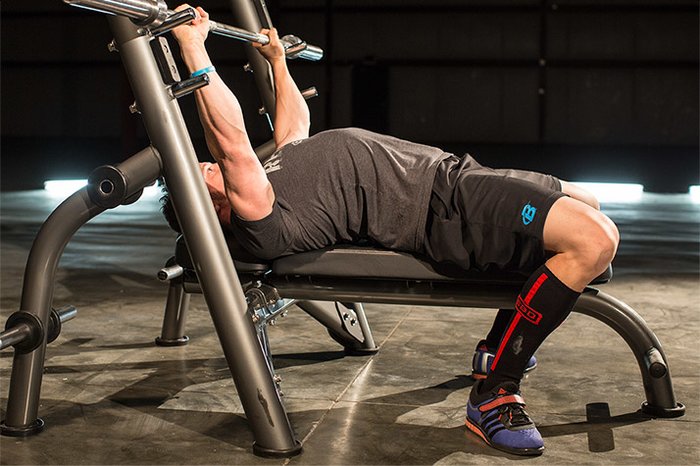
If you're not into powerlifting, your back arch doesn't need to be that exaggerated. However, always keep a slight arch in your lower back. If you're a powerlifter, arch your back as much as you can to minimize the distance the bar has to travel.
Set Your Grip
Grab the bar tightly and with authority. Grip the heck out of it! Hold the bar as far down your palm as possible. If the bar is too high in your hand, or even in your fingers, your wrist will bend backward. A straight wrist provides optimal force.
Your grip width will depend on your body type and goals. People with longer arms will need to grip wider, as will those who are looking to push maximum weight, such as in competitive powerlifting. Those with shorter arms will need a narrower grip, and if you're lifting primarily in hypertrophy rep ranges, this may be a better position for the majority of your lifting.
However, I don't like exaggerated grips in either direction. Most people will grip around the barbell rings or just inside them. I don't recommend a false grip because it can be dangerous. Wrap your thumb.
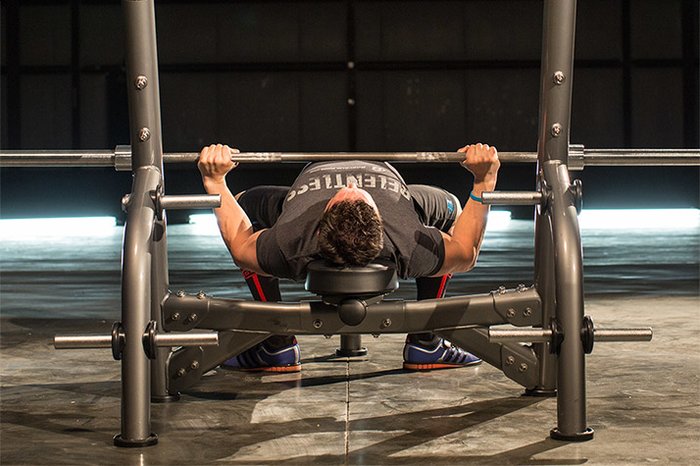
Brace and Unrack
Take in a deep breath, unrack the bar, then let the breath out. Don't waste energy lifting the bar off the rack, especially if it's loaded with a lot of weight. If you don't have a partner to help you, drive your back into the bench so hard the bar just pops off.
Breathe In and Lower the Bar
Before you move the bar downward, take another deep breath. Hold that breath and use it to brace your abdominal wall. As you do this, think about bending the bar into a U-shape with your hands. Bending the bar will allow you to tuck your elbows naturally to engage your lats and protect your shoulders.
Hold your breath until you get past the concentric sticking point of your press, then breathe out forcefully as you push.
Touch Your Chest
Where you touch the bar on your body will depend on how long your arms are and where you grip the bar. Whatever the case, your forearms should be at 90 degrees from the ground in this bottom position. If it's more or less, you may lose force.
If you have long arms and a narrow grip, you'll touch farther down on your body. If you have short arms and a wide grip, the bar will touch higher on your chest. Most people will hit anywhere between their top ab and their nipple line. Wherever the bar hits you, try to hit the same spot every rep.
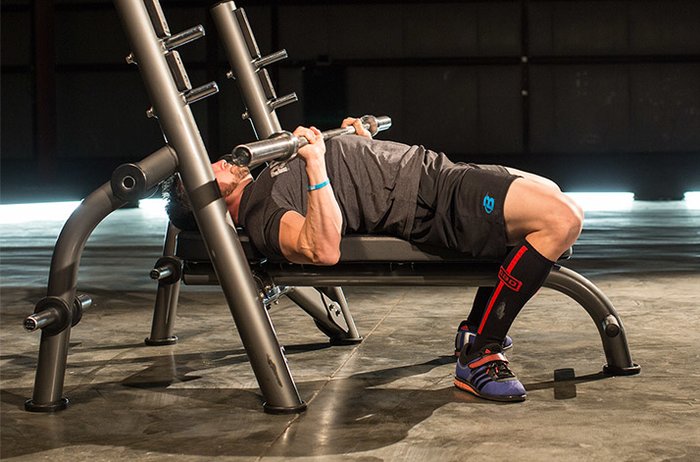
Push With Leg Drive
Once the bar has made contact with your torso, initiate the upward movement by tightening your glutes and driving your legs into the ground. No, that's not cheating. Using leg drive will allow you to stay tight and bench more weight.
Remember, breathe out forcefully through the sticking point. As you press up, think about throwing the bar back. The bar should move in a slight arch or "reverse J" pattern.
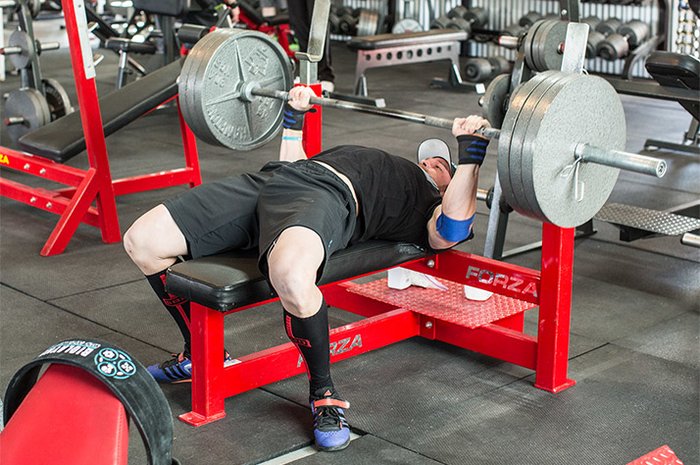
Where Most Bench Presses Go Wrong
As you can see, the bench is actually more complex than most people initially think. The most common problem I see is people bouncing the bar off their chests. This is problematic not only because it puts a lot of pressure on the sternum, but also because it's impossible to keep your body tight if you're bouncing the bar. Besides, if you're bouncing the weight off your chest, how can you say you actually lifted it?
Most people don't breathe or brace properly, either, so make that a priority—both when you unrack, and before you lower the bar. You'll be amazed by how much more weight you'll be able to move if you brace your abs with a big breath.
I also see many people flaring their elbows because they believe it will lead to more pec-muscle recruitment. Even if it does, flaring your elbows is not worth the danger. That's how I tore my pec: My grip was too wide and my elbows were too flared. Flared elbows mean your lats aren't engaged and you're benching inefficiently.
It's also common to see people roll their shoulders forward at the top of the movement, unlocking their shoulder blades as they push up, and moving their feet. Anything that veers away from a tight body and pinched shoulder blades leads to weak, dangerous lifts. Keep stable and stay tight.
Bench Press Equipment
Although you don't really need anything other than your own body in order to do a bench press, there are specific pieces of equipment you can use to make your bench press safer and more effective.
Tools generally come into play when you're getting into competitive lifting. The more competitive you are, the more the equipment matters. If you're just starting out, don't worry about the gear too much, just focus on perfecting your form.
Wrist Wraps
The most important pieces of equipment I use on the bench press are my wrist wraps. To move the most weight, you need to create the maximum amount of force. In order to do that, you need to keep your wrists vertical. Wrist wraps can help keep your wrists in a straight line, so I always recommend them.
Your wrap should completely cover the wrist joint, so it should be long enough to wrap a little bit above and below the wrist. I prefer a wrap that's 18-24 inches so I can get enough revolutions to wrap above and below my wrist. However, you can get wraps anywhere from 12-36 inches. Tightness is a point of preference. In general, though, wrap as tight as you can without causing pain or numbness. This will give some support to your wrists under a heavy load.
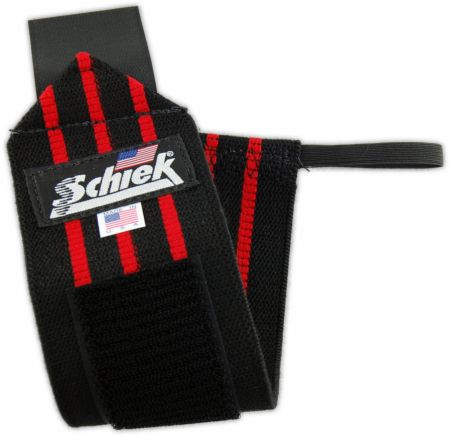
Footwear
Your feet are your base. They connect your body to the ground, so what you put on them matters—yes, even when benching! Generally, footwear comes down to personal preference, but it's helpful to have something on your feet that will help you grip the floor when you press.
I like to use weightlifting shoes because they have an elevated heel, which makes me feel like my feet connect to the ground better. They also have a really grippy bottom to keep my feet from sliding. Other people, though, prefer to use shoes with very flat soles, like wrestling shoes or Chuck Taylors. Whatever your pick, try to keep your footwear consistent every time you bench.
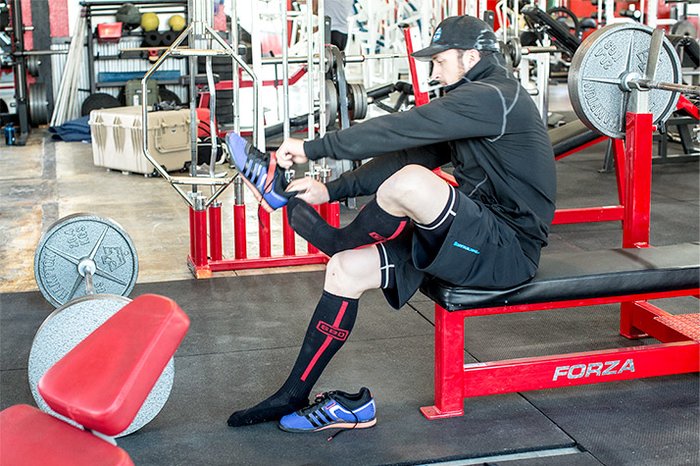
Whatever your pick, try to keep your footwear consistent every time you bench.
Chalk
I like to put chalk on my shoulders and upper back—wherever my back comes into contact with the bench—to prevent me from sliding up on the bench itself and help me create a more stable base.
Chalk isn't a bench necessity by any means, but if you're going heavy and you happen to have a partner, have him or her put some on your upper back. You may actually notice a difference in your numbers and stability.
Go Forth and Bench!
Now you have the tools to bench safely and effectively. The bench press is a skill, just like the squat or any other major lift. The more you practice your bench press, the better you'll be at it. Start light and work up in weight as you begin to understand the movement and feel more comfortable doing it.
